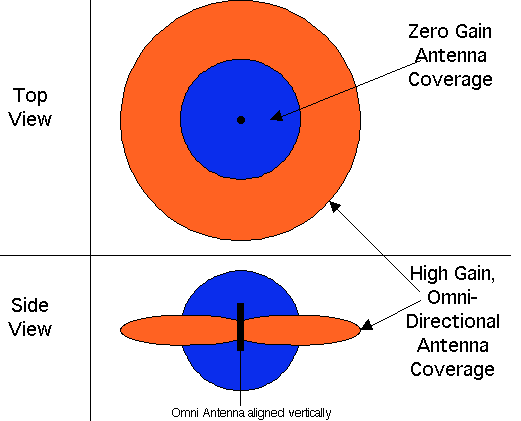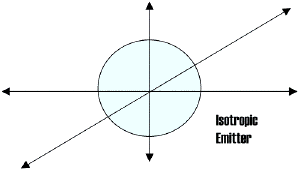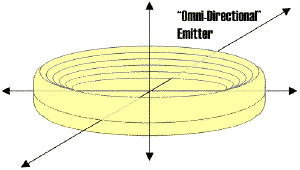Omni-Directional Antenna Discussion:
"Omni-directional" antennas are usually used for point-to-multipoint networks. They increase the transmitting power/receiving sensitivity in one plane at the expense of the same in another. To visualize what happens when you attach a "omni-directional" antenna, let's start with a stock base station.
A stock base station has a so-called "isotropic" transmitter/receiver built into it. Theoretically, if you suspended a ABS in a three-dimensional space that the coverage would resemble a sphere with the ABS at its center. Enter the sphere and you have coverage, exit it and you don't. In reality, the limitations of antenna design, interference, etc. usually result in somewhat less uniform coverage.
A "omni-directional" antenna will basically flatten the sphere. So, as the range in one plane is increased, the range in another will suffer. For example, the gain of "omni-directional" antennas are usually specified in the horizontal and the vertical planes. While the horizontal coverage increases with the gain of the antenna, the vertical coverage decreases. The simple sketch below gives you an idea.

As the gain increases, the coverage field starts to distort from a ball to a flat pancake. Furthermore, as the gain of a omni-directional pole antenna increases, so does its length. A 9dbi pole antenna is about a sixteen inches long while its 15dbi counterpart is 70 inches long! Here is an attempt to show the effect in three dimensions.


When you look at the coverage pattern of a stock ABS (with its isotropic emitter), it becomes clear why it should be placed centrally within your house. This sort of placement maximizes the volume in the house that is covered by the ABS.
When you add higher-gain omni-directional antennas, the coverage pattern changes in ways that are beneficial in one plane while reducing coverage in another. In the sketches above, note how the isotropic coverage incorporates more vertical volume than the coverage influenced by a "omni-directional" antenna. Hence why you might encounter some pitfalls when adding a "omni-directional" antenna in a multi-story house. Suddenly, the antenna may no longer cover the third floor if the base station is on the ground floor!
This is why I put "omni-directional" in quotation marks. In fact, these antennas only increase sensitivity on one plane. Yes, they are omni-directional in that plane, but we live in a three, not a two dimensional world! In fact, if increasing the range of your wireless access point in all three dimensions what you're trying to achieve, then one attractive option may be to use the YDI Max-Ranger at Fab-Corp. which is an $150 integrated amplifier and antenna.
For less money, you can buy the 4.5dbi gain Blade Omni Directional Black Antenna w/MC from Fab-Corp for about $45. It's a great addition to "Graphite" base stations because it has a short antenna cable and the increase in gain should increase the range of your ABS in the horizontal plane by 50%. I would avoid the readily-available Lucent "Extender Antenna". While it has a antenna gain of 5dbi,its net gain is only 2.5 db (after apparently fairly disastrous connector and wire losses). This equates to about 15-30% range increase in real life. Considering it usually costs $20 more than the Fab-Corp blade antenna, there is no good reason to buy it.
For higher-gain applications using just an antenna, I recommend the economical ($57) 9 dBi Fiberglass Omni-directional Antenna at Fab-Corp. However, you'll have to also buy a $19 12 inch ORiNOCO/Avaya to N-Male Pigtail to connect it to the base station. However, 9dbi antennas start to get pretty long. Furthermore, as you start to concentrate the signal using high gain antennas, you also increase the risks associated with Microwave exposure.
Below is a table showing the maximum gain that "omni-directional" antennas can have when used with different base stations. As you can see, Apple base station transmitters are unlikely to go over the legal 4W (36dbm) EIRP limit set by the FCC. However, in other countries, microwave limits may be set much lower than in the USA.
| Sample Mfgrs. & Models | Transmitter Power | Max. Allowable External Antenna Gain in Multipoint Use set by FCC | ||
|---|---|---|---|---|
| (mW) | (dbm) | |||
| 802.11b only | "Graphite" ABS | 32 | 15 | 21dbi |
| "Snow" ABS | 35? | 15? | ||
| Cisco Aironet 350 | 100 | 20 | 16dbi | |
| Demarctech Reliawave 200mW | 200 | 23 | 16dbi | |
| 802.11b&g | "Extreme" ABS | 35? | 15? | |
| SMC SMC2804WBR | 35 | 15 | 21dbi | |
| Cisco Aironet 1100 | 100 | 20 | 16dbi | |
Note: Please do not place powerful transmitter and antenna combinations near living things - the frequency of the signal is the same as your standard microwave oven. Even at the 4Watt EIRP limit, something placed nearby is slowly being cooked. Instead, see if lower output levels are satisfactory - for most people they are. Use this EIRP calculator to see how powerful your proposed transmitter and antenna combination will be. The Transmitter output and antenna gain should be indicated in the respective equipment documentation.
When selecting an antenna for "Graphite" or "Snow" base stations, look for one that has a "Orinoco" or "MC Card" cable attached to it. "Extreme" base stations without the external antenna option can also be extended using MC-Card Plugs. The external port on "Extreme" base stations accepts MCX-style plugs and requires a special autosensing circuit or a Type 3 or Type 4 Lightning Protector to work. Simply attaching an antenna with a MCX plug will not work.
As stated in their respective extension pages, "Snow" or "Extreme" base stations w/o external antenna ports may not benefit as much from simply attaching an external antenna to the MC-Card port found on the respective transmitters. The issue appears to be the small circuit board which is bypassed when a MC-Card connector is plugged directly into a second generation Airport or a third generation Airport Extreme transmitter. (see the primer on the base station differences here). For these base stations, the YDI Max-Ranger at Fab-Corp seems to be the most promising way to extend the range.
Airport "Extreme" base stations with external antenna ports can be extended via Dr. Bott ExtendAir antennas. However, judging from the feedback at the Apple Discussion boards, many people are not happy with them. Another option is the $45 HyperGain Range Extender 5 dBi Blade Omni that features the necessary auto-sensing circuit to connect an Extreme base station. However, considering the customer-unfriendly policies at Hyperlinktech, I cannot recommend shopping there.
In closing, I would appreciate any feedback you may have using the above products or other antennas. Furthermore, if you know of other good antenna sources besides Fab-Corp, please let me know. Cheers!
Constantin
